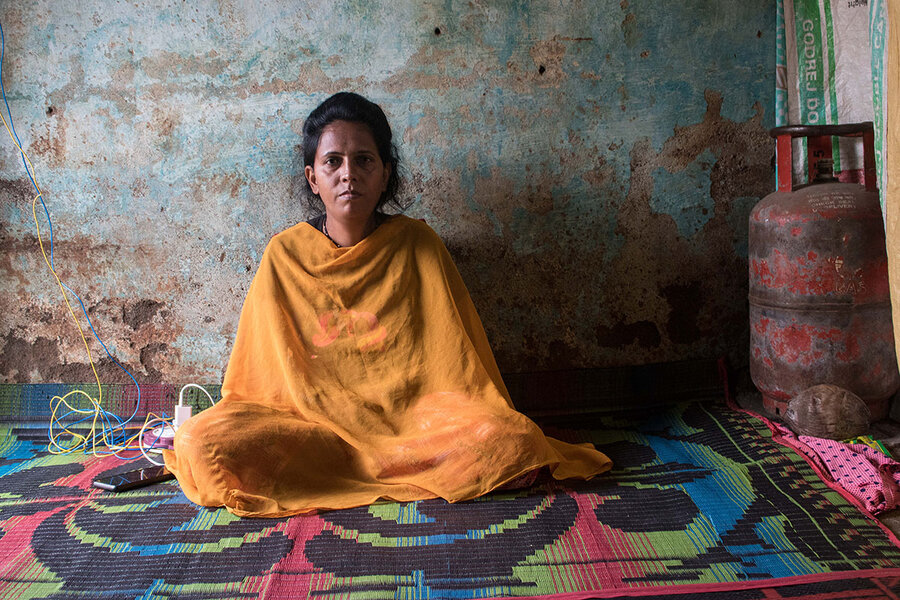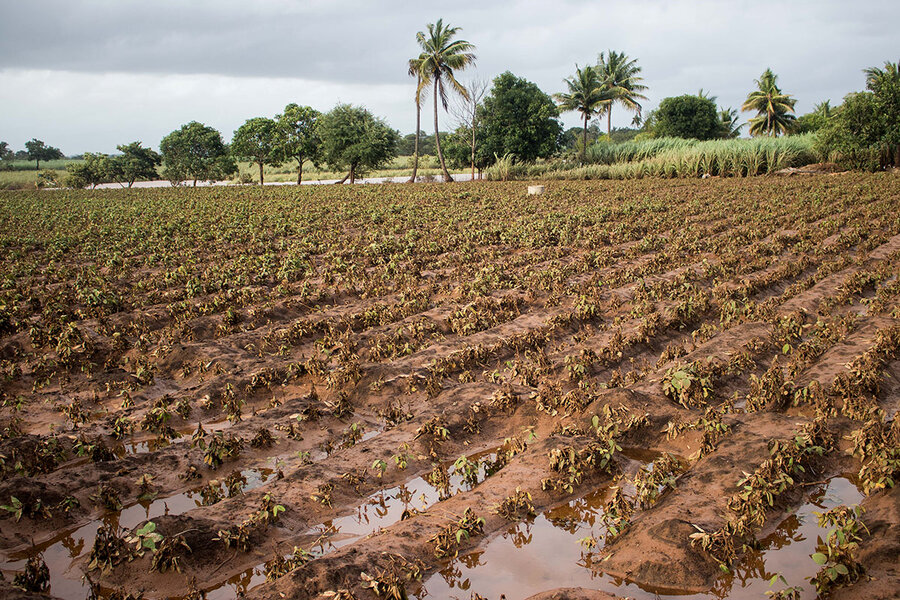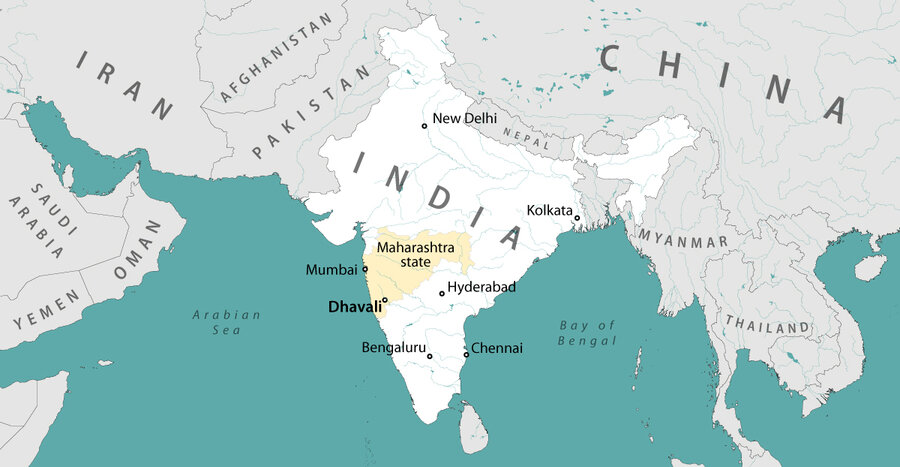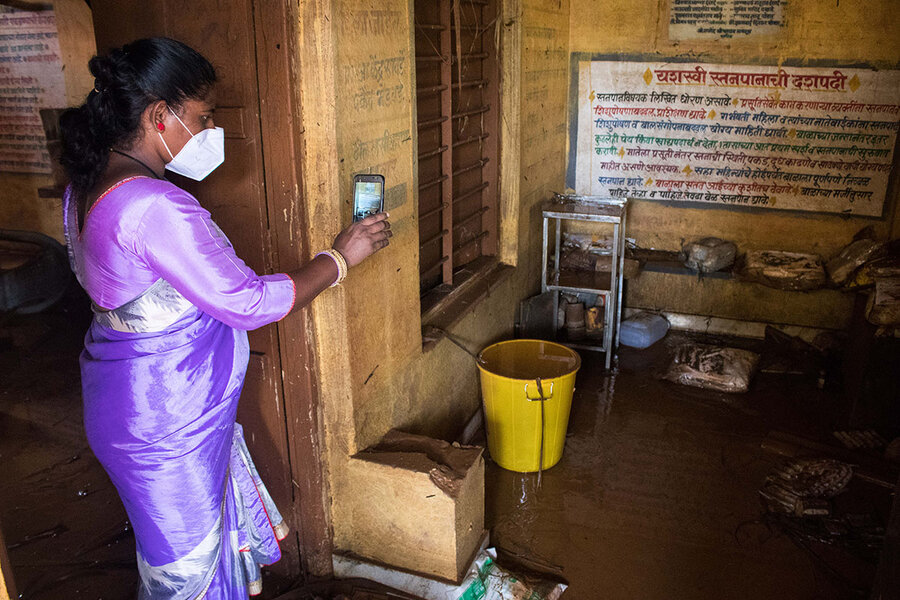Why COP26 stakes are so high for India’s women
Loading...
| Dhavali, India
When the river in her village in western India started to rise, Krishnatai Birajdar tried to keep calm. For three days it rose by two feet a day, and she figured it would slowly recede, as it had done before. But then it overran its banks. “Everyone was running around, carrying whatever they could to escape the floods,” she says.
Ms. Birajdar, a seamstress who is disabled in both legs, was rescued by a neighbor.
Why We Wrote This
In rural India, an increase in severe floods is uprooting people and deepening poverty. It’s a reminder that the world’s challenge is not just to reduce carbon emissions but also to support affected people.
That was in 2019. The region in western India faced deadly floods again this July, though the impact of similar heavy rains in Europe and China received greater global attention.
This time, Ms. Birajdar had moved to a nearby village that didn’t flood. But “the entire rural economy collapsed. Even today, people don’t have money to eat two meals,” she says.
How to not only combat climate change but also help the most affected people is an urgent priority for the United Nations climate summit this week in Scotland.
Hardship like that faced by Ms. Birajdar is increasingly common across the developing world. The Swiss-based Internal Displacement Monitoring Centre estimates that about 318 million people have been forced to leave their homes since 2008 due to weather-related disasters.
When the river in her village in western India started to rise, Krishnatai Birajdar tried to keep calm. For three days it rose by two feet a day, and she figured it would slowly recede, as it had done before. But then it surged and overran its banks, sparking panic in the community. “Everyone was running around, carrying whatever they could to escape the floods,” she says.
But Ms. Birajdar, a 32-year-old seamstress who is disabled in both legs, was left behind in her single-room mud house. It took the intervention of her neighbor, Pramila Kamble, to dash back to rescue her. “We were racing against the floods,” recalls Ms. Kamble.
The flood occurred in August 2019 and it would be three months before Ms. Birajdar was ready to move back to Dhavali (population 2,969) in Maharashtra state. The village flooded again in July this year when eight districts in the state were inundated, killing hundreds of people. The floods, triggered by heavy rainfall, coincided with deadly floods in Western Europe and central China, but received less global attention.
Why We Wrote This
In rural India, an increase in severe floods is uprooting people and deepening poverty. It’s a reminder that the world’s challenge is not just to reduce carbon emissions but also to support affected people.
This time, Ms. Birajdar had moved to a nearby village that didn’t flood, but she still suffered the economic fallout. “The entire rural economy collapsed. Even today, people don’t have money to eat two meals,” she says.
Such hardship is increasingly common not just in India but across much of the developing world where rural communities are vulnerable to climate-related disasters. The Swiss-based Internal Displacement Monitoring Centre estimates that 318.3 million people were forced to leave their homes since 2008 as a result of storms, wildfires, and other weather-related disasters. Of the 2 million people who died in such disasters between 1970 and 2019, some 91% lived in developing countries, according to the World Meteorological Organization.
World leaders are gathered in Glasgow, Scotland, for a major United Nations climate conference on how to face the challenge of limiting greenhouse gas emissions so as to avoid global warming on an even larger and more disruptive scale. Among them was Indian Prime Minister Narendra Modi, who pledged significant new efforts to reduce emissions in his country, which is highly exposed to climate risks from heat waves to flooding.
India is currently the world’s fourth largest carbon emitter, after China, the United States, and the European Union, a 27-member bloc. But India’s historic contribution is more modest: Between 1750 and 2018 it emitted 51 billion metric tons of carbon dioxide, compared with 400 billion by the U.S. And while China has overtaken the U.S. in overall emissions, the U.S. still has much higher per capita emissions, on par with Saudi Arabia.
India’s environment ministry has said that it will seek financial compensation from developed countries for climate-related losses. The idea of compensation, which was referenced in the 2015 Paris climate agreement, is separate from pledges by rich countries to mobilize financing for climate mitigation and adaptation in developing countries.
Monsoon disrupted
Across India, tens of millions of farmers depend on monsoon rains. But the monsoon patterns have changed, bringing heavy rains for a few hours or days, followed by longer dry spells. The result is lower overall rainfall along with increased flooding.
“The western side of the Indian Ocean is warming at a faster rate, generating a lot of moisture, which comes as a surge leading to extreme precipitation and flooding,” says Subimal Ghosh, a professor of civil engineering at the Indian Institute of Technology in Bombay who contributed to the U.N.’s Intergovernmental Panel on Climate Change report.
Last month, Maharashtra’s state government announced a relief package worth $1.3 billion for farmers whose crops were flooded this summer over an area of 5.5 million acres. India’s federal government has been slower to respond, sending survey teams to affected areas months after the first inundations.
But as relief efforts slowly gear up, the pressure grows on women displaced by repeated floods. “Who do you think faces the brunt of this uncertainty? It’s the poor women,” says Ms. Birajdar, who now depends on her widowed mother, Nilabai, a farm laborer.
After the 2019 floods, the family borrowed $400; when they couldn’t repay the debt with interest, they took another loan of $800. They owe money to a women’s self-help group and moneylenders. “We’ve run out of people to ask money from,” says Ms. Birajdar.
Her anxiety over money and trauma from the flooding have led her, she says, to suicidal thoughts. Both she and her mother say they have suffered fatigue, pain, and other physical ailments since the 2019 floods.
Netradipa Patil, a community health care worker in Maharashtra, sees a similar pattern across the region when she assesses the mental health of women facing extreme environmental and financial hardship. “In [the state government’s] flood rehabilitation plan, the entire psychosocial support is missing, and now this is deteriorating women’s physical health,” she says.
She calls the state government response to the mental health crisis ineffective, noting that in her town flood victims were given multiple-choice questionnaires to gauge their condition. “You have to spend hours with people to address mental health issues,” Ms. Patil says.
A college dream postponed
A report last year by the U.N.’s Disaster Risk Reduction office found a sharp annual increase in climate-related disasters since 2000. India faced repeated droughts and 17 floods annually on average, and these have had a disproportionate impact on young girls.
These include Amruta Kamble, Ms. Birajdar’s former neighbor. She was planning to go to college, but the family lost their house and cattle shed in the 2019 floods. They received $635 in government compensation, but ended up in debt to the tune of $1,200.
Now 21 years old, Amruta spends at least six hours daily looking after their cattle. “I want to study, but we can’t afford the college fees,” Amruta says. Even making a living from cattle is hard: Fodder is expensive, but without it the cattle don’t produce milk. So the Kambles rely on local farmers to donate feed, while the mother also works as a farm laborer.
Narayan Gaikwad, a farmer in nearby Jambhali village, says he’s distributed over 11,000 pounds of animal feed since 2019. “We can help others because the floods haven’t reached us. For how long will community efforts work, though?” asks Mr. Gaikwad.
Dhavali, surrounded by sugar cane fields, is accessible via a single road, complicating flood rescue operations. It has one primary school. The Krishna River that overflowed its banks also provides a transportation link to the neighboring district.
While community solidarity has kept hopes afloat in Maharashtra and other flood-prone regions, what India needs now is a policy response that incorporates grassroots opinion, says Professor Ghosh, who runs an interdisciplinary program in climate studies. All stakeholders must be involved, including scientists, engineers, and farmers. “There should be a merger of the top-down and bottom-up approach to build participatory models,” he says.
After the floodwaters receded in 2019, the elder Ms. Kamble spent more than 100 hours cleaning her house, trying to eliminate the stench. That meant more lost income for her family. For farmers, it takes around 45 days for fields to drain, after which they apply fertilizers to improve the soil quality. But they often delay tilling the soil until government surveyors visit the village, in the hope that compensation will be paid.
Ms. Kamble is now trying to scrounge enough to move out of the flood-prone area, joining the swell of migrants in India’s cities. “If we save enough,” she says, “we will migrate.”










